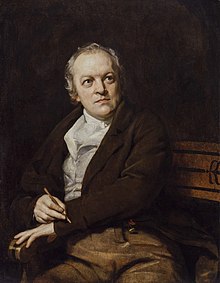
Back William Blake Afrikaans وليم بليك Arabic وليم بليك ARZ William Blake AST Vilyam Bleyk Azerbaijani ویلیام بلیک AZB Уільям Блэйк Byelorussian Ўільям Блэйк BE-X-OLD Уилям Блейк Bulgarian উইলিয়াম ব্লেইক Bengali/Bangla
William Blake | |
|---|---|
 Portrait by Thomas Phillips (1807) | |
| Born | 28 November 1757 Soho, London, England |
| Died | 12 August 1827 (aged 69) Charing Cross, London,[1] England |
| Occupation |
|
| Education | Royal Academy of Arts |
| Genre | Poetry |
| Literary movement | Romanticism |
| Notable works | Songs of Innocence and of Experience, The Marriage of Heaven and Hell, The Four Zoas, Jerusalem, Milton |
| Spouse | |
| Signature | |
William Blake (28 November 1757 – 12 August 1827) was an English poet, painter, and printmaker. Largely unrecognised during his life, Blake is now considered a seminal figure in the history of the poetry and visual art of the Romantic Age. What he called his "prophetic works" were said by 20th-century critic Northrop Frye to form "what is in proportion to its merits the least read body of poetry in the English language".[2] While he lived in London his entire life, except for three years spent in Felpham,[3] he produced a diverse and symbolically rich collection of works, which embraced the imagination as "the body of God",[4] or "human existence itself".[5]
Although Blake was considered mad by contemporaries for his idiosyncratic views, he came to be highly regarded by later critics and readers for his expressiveness and creativity, and for the philosophical and mystical undercurrents within his work. His paintings and poetry have been characterised as part of the Romantic movement and as "Pre-Romantic".[6] A theist who preferred his own Marcionite style of theology,[7][8] he was hostile to the Church of England (indeed, to almost all forms of organised religion), and was influenced by the ideals and ambitions of the French and American revolutions.[9][10] Although later he rejected many of these political beliefs, he maintained an amicable relationship with the political activist Thomas Paine; he was also influenced by thinkers such as Emanuel Swedenborg.[11] Despite these known influences, the singularity of Blake's work makes him difficult to classify. The 19th-century scholar William Michael Rossetti characterised him as a "glorious luminary",[12] and "a man not forestalled by predecessors, nor to be classed with contemporaries, nor to be replaced by known or readily surmisable successors".[13]
- ^ "Blake & London". The Blake Society. 28 March 2008. Archived from the original on 15 September 2015. Retrieved 15 August 2014.
- ^ Frye, Northrop and Denham, Robert D. Collected Works of Northrop Frye. 2006, pp 11–12.
- ^ Thomas, Edward. A Literary Pilgrim in England. 1917, p. 3.
- ^ Yeats, W. B. The Collected Works of W. B. Yeats. 2007, p. 85.
- ^ Wilson, Mona. The Life of William Blake. The Nonesuch Press, 1927. p. 167.
- ^ The New York Times Guide to Essential Knowledge. 2004, p. 351.
- ^ "Historiographic Sophistications: Marcionism as a Genealogical Category". 29 December 2020.
- ^ "The Artful Religion of William Blake". 2 November 2016.
- ^ Blake, William. Blake's "America, a Prophecy"; And, "Europe, a Prophecy". 1984, p. 2.
- ^ Wilson, Andy (2021). "William Blake as a Revolutionary Poet". Retrieved 29 January 2021.
- ^ Kazin, Alfred (1997). "An Introduction to William Blake". Archived from the original on 26 September 2006. Retrieved 23 September 2006.
- ^ Blake, William and Rossetti, William Michael. The Poetical Works of William Blake: Lyrical and Miscellaneous. 1890, p. xi.
- ^ Blake, William and Rossetti, William Michael. The Poetical Works of William Blake: Lyrical and Miscellaneous. 1890, p. xiii.
© MMXXIII Rich X Search. We shall prevail. All rights reserved. Rich X Search